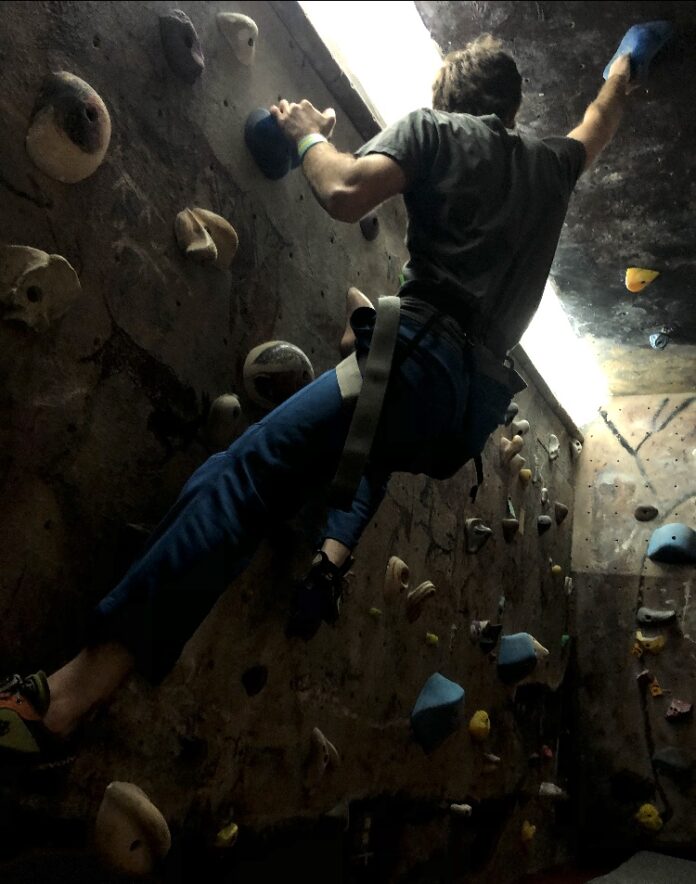By MIA QUICK
Web Editor
As warmer weather approaches and the rock climbing community itches to drive up to the ‘Gunks, Albany’s Indoor Rock (A.I.R.) Gym offers more than just a quick fix for your climbing needs. Alongside an impressive array of bouldering, top-roping, and lead climbing routes for climbers new and old is a unique immersive cave diving experience, the only one like it in the Capital Region. While top-ropers scale walls and boulderers grip impossible holds, cave dwellers listen from inside the walls.
A.I.R. opened in 1994, and is the closest climbing gym to Saint Rose’s campus that is also beginner friendly. Their main mission is to hone the skills of all climbers, of any level, with the added benefit of about a half mile of indoor caving systems.
The cave system snakes its way throughout the walls and becomes an interactive part of the climbing experience. Small “stalactite pods,” or beautied spying pockets, allow cave crawlers to take a break from the pitch black tunnels and be face-to-face with top-ropers.
“It was cool to find your way through and also to know that there were no dead ends, so there was always a way out,” said Jake Castellano, a teaching assistant at Woodstock Day School.
A.I.R.’s cave feature is claimed to be the nation’s only indoor tunnel system, and when you no longer hear children tapping from stalactite pods above you, the caves are an exciting experience that you may not get a chance to tackle again. Within the tunnels is a slide and bridge, periscopes for observation, a mirror room, and many other features. If you tire of climbing up inclines or dropping feet first into the unknown there are 60 feet of ziplines to take you to another portion of the caves.
When you first arrive at the gym, an employee will greet you, have you sign a waiver, give you strangely tight climbing shoes, and introduce you to the rules and regulations of properly climbing with ropes and harnesses. There’s an introduction to the belay agreement, a communication courtesy to ensure climber safety, and a supervised practice run to solidify the instructions.
It costs $20 for a day pass that includes shoe and harness rental and that allows you to leave and come back. A.I.R. also offers monthly passes for $54 (without equipment rental) and $80 per month with equipment rental.
There are over 15 walls with at least four routes per wall to choose from with overhangs, floor-to-ceiling cracks, and trackable ceiling climbs. The different routes are taped with the varying difficulty levels, if they’re for top-roping or bouldering, and marked with an ‘X’ when you’ve reached the end.
The number of walls, routes, and levels provide plenty of challenges for climbers. “You can go up one path five times and by the fifth time you’ll learn how to grip better, which ones to actually look for, and you kind of look at it as a puzzle,” said Castellano.
Top-roping was the most enjoyable aspect of A.I.R., mostly because the technique helps keep you from falling to the ground when you slip or lose your grip and lets you push yourself harder as you climb, as well as being easier for your belayer.
If you don’t have the time to gear up in a harness and learn belaying etiquette, or just want to climb without a partner, bouldering is untethered climbing that typically doesn’t take you too high into the air and with padding on the ground to break your fall. The majority of the walls and differing routes can be bouldering routes as well, and padding can be moved to wherever you decide to set your course.
A.I.R. offers summer climbing clinics and conducts outdoor climbing excursions, and also hosts group parties and events.
A.I.R. revives the childhood dream of climbing anything in sight and makes it socially acceptable while simultaneously working out muscles in parts of your body you didn’t know existed.
However, Castellano believes the need runs even deeper. “I think there’s an inherent need to climb with humans, since we’re descendants from apes. It seems rational to surmise that we still need to climb,” he said.


